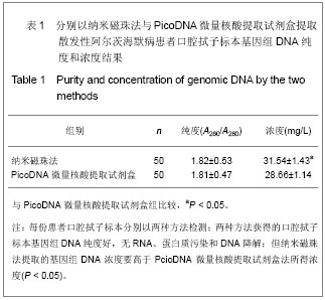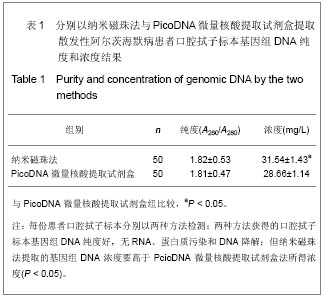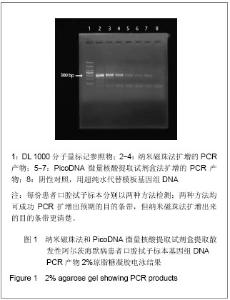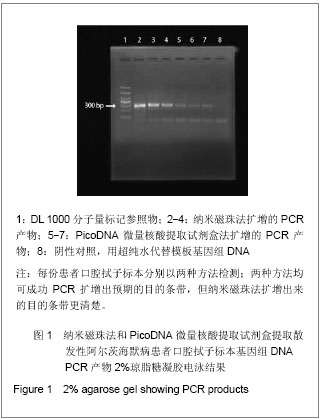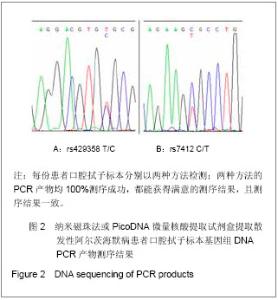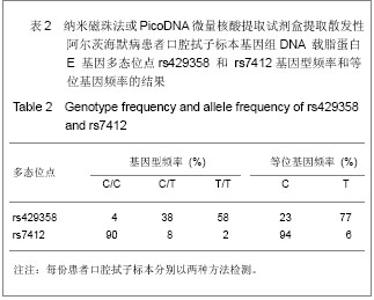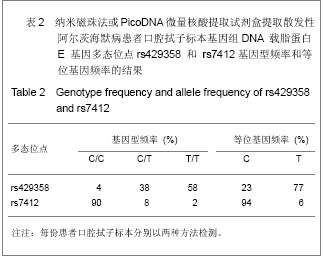Chinese Journal of Tissue Engineering Research
Previous Articles Next Articles
Magnetic nanoparticles versus a commercial kit for apolipoprotein E gene polymorphism analysis
Wu Ting, Yi Li, Huang Ying, Wu Jun
- Department of Neurology, Peking University Shenzhen Hospital, Shenzhen 518036, Guangdong Province, China
-
Received:2013-01-15Revised:2013-01-21Online:2013-09-17Published:2013-09-17 -
Contact:Yi Li, Associate professor, Chief physician, Department of Neurology, Peking University Shenzhen Hospital, Shenzhen 518036, Guangdong Province, China yilitj@hotmail.com -
About author:Wu Ting★, Studying for master’s degree, Department of Neurology, Peking University Shenzhen Hospital, Shenzhen 518036, Guangdong Province, China -
Supported by:Economy, Trade and Information Commission of Shenzhen Municipality, No. 201002063*, JC201105180757A*
CLC Number:
Cite this article
Wu Ting, Yi Li, Huang Ying, Wu Jun. Magnetic nanoparticles versus a commercial kit for apolipoprotein E gene polymorphism analysis[J]. Chinese Journal of Tissue Engineering Research, doi: 10.3969/j.issn.2095-4344.2013.38.016.
share this article
| [1] Lauderback CM,Kanski J,Hackett JM,et al.Apolipoprotein E modulates Alzheimer's Abeta(1-42)-induced oxidative damage to synaptosomes in an allele-specific manner.Brain Res.2002;924(1):90-97. [2] Raffai RL,Dong LM,Farese RV Jr,et al.Introduction of human apolipoprotein E4 "domain interaction" into mouse apolipoprotein E. Proc Natl Acad Sci U S A. 2001;98(20): 11587-11591. [3] Li L,Thompson PA,Kitchens RL.Infection induces a positive acute phase apolipoprotein E response from a negative acute phase gene: a role of hepatic LDL receptors. J Lipid Res. 2008; 49(8):1782-1793. [4] Laffont I,Takahashi M,Shibukawa Y,et al.Apolipoprotein E activates Akt pathway in neuron-2a in an isoform-specific manner. Biochem Biophys Res Commun. 2002;292(1):83-87. [5] Huang Y.Aβ-independent roles of apolipoprotein E4 in the pathogenesis of Alzheimer’s disease. Trends Mol Med.2010; 16(6): 287-294. [6] Luchsinger JA,Mayeux R.Cardiovascular risk factors and Alzheimer’s disease. Curr Atheroscler Rep.2004;6(4):261-266. [7] Lahiri DK.Apolipoprotein E as a target for developing new therapeutics for Alzheimer's disease based on studies from protein, RNA, and regulatory region of the gene.J Mol Neurosci. 2004;23(3):225-233. [8] Mahley RW,Weisgraber KH,Huang Y.Apolipoprotein E4: a causative factor and therapeutic target in neuropathology, including Alzheimer's disease. Proc Natl Acad Sci U S A.2006; 103(15):5644-5651. [9] Kline A.Apolipoprotein E,amyloid-ß clearance and therapeutic opportunities in Alzheimer's disease.Alzheimers Res Ther. 2012; 4(4):32. [10] Ferri CP,Prince M,Brayne C,et al. Global prevalence of dementia :a Delphi consensus study.Lancet.2005; 366(9503): 2112-2117. [11] Lasser RA,Dukoff R,Levy J,et al. Apolipoprotein E epsilon 4 allele in association with global cognitive performance and CSF markers in Alzheimer's disease. Int J Geriatr Psychiatry. 1998;13(11):767-774. [12] Ewers M,Zhong Z,Bürger K,et al.Increased CSF-BACE 1 activity is associated with ApoE-epsilon 4 genotype in subjects with mild cognitive impairment and Alzheimer's disease.Brain.2008;131(Pt 5):1252-1258. [13] Kim J,Basak J,Holtzman DM.The Role of Apolipoprotein E in Alzheimer’s Disease. Neuron.2009;63(3):287-303. [14] Lahiri DK,Schnabel B. DNA isolation by a rapid method from human blood samples: effects of MgCl2,EDTA, storage time, and temperature on DNA yield and quality. Biochem Genet. 1993;31(7-8):321-328. [15] Maloney B,Ray B,Hayden E,et al.Development and validation of the high-quality ‘Rapid Method for Swab’ (RMS) to genotype the HTTLPR serotonin transporter (SLC6A4) promoter polymorphism.Psychiatr Genet. 2009;19(2):72-82. [16] Ilveskoski E,Lehtimäki T,Erkinjuntti T,et al.Rapid apolipoprotein E genotyping from mailed buccal swabs.J Neurosci Meth.1998;79(1):5-8. [17] Walker AH,Najarian D,White DL,et al.Collection of genomic DNA by buccal swabs for polymerase chain reaction-based biomarker assays. Environ Health Perspect.1999;107 (7): 517-520. [18] Rogers NL,Cole SA,Lan HC,et al.New saliva DNA collection method compared to buccal cell collection techniques for epidemiological studies. Am J Hum Biol 2007;19(3):319-326. [19] Andrisin TE,Humma LM,Johnson JA.Collection of genomic DNA by the noninvasive mouthwash method for use in pharmacogenetic studies.Pharmacotherapy. 2002;22(8): 954-960. [20] Rusanen P,Siikala E,Uittamo J,et al.A novel method for sampling the microbiota from the oral mucosa.Clin Oral Investig.2009;13(2):243-246. [21] Badulli C,Sbarsi I,Di Giorgio D,et al.A new approach to safely type for HLA the HIV infected people eligible to abacavir therapy: saliva or buccal swab as reliable DNA sources.Clin Chim Acta.2011;412(21-22):1995-1998. [22] McKhann G,Drachman D,Folstein M,et al.Clinical diagnosis of Alzheimer’s disease: report of the NINCDS-ADRDA Work Group under the auspices of Department of Health and Human Services Task Force on Alzheimer’s Disease. Neurology. 1984;34(7) :939-944. [23] Jack CR Jr,Barkhof F,Bernstein MA,et al.Steps to standardization and validation of hippocampal volumetry as a biomarker in clinical trials and diagnostic criterion for Alzheimer's disease.Alzheimers Dement. 2011;7(4):474-485. [24] Koch W, Ehrenhaft A,Griesser K,et al.TaqMan systems for genotyping of disease-related polymorphisms present in the gene encoding apolipoprotein E. Clin Chem Lab Med.2002; 40(11):1123-1131. [25] Wijnen PA,Drent M,van Dieijen-Visser MP,et al. Pharmacogenetic testing after a simple DNA isolation method on buccal swab samples.Pharmacogenomics. 2009; 10(6):983-987. [26] Le Marchand L,Lum-Jones A,Saltzman B,et al.Feasibility of collecting buccal cell DNA by mail in a cohort study. Cancer Epidemiol Biomarkers Prev. 2001;10(6):701-703. [27] Drobnik A,Judd C,Banach D,et al.Public health implications of rapid hepatitis C screening with an oral swab for community-based organizations serving high-risk populations.Am J Public Health.2011;101(11):2151-2155. [28] Wijnen PA,Op den Buijsch RA,Cheung SC,et al.Genotyping with a dried blood spot method: a useful technique for application in pharmacogenetics. Clin Chim Acta.2008; 388(1-2):189-191. [29] Gavriel G,Modi N,Stanier P,et al.Neonatal buccal cell collection for DNA analysis. Arch Dis Child Fetal Neonatal Ed.2005;90(2):F187. [30] Mitsouras K,Faulhaber EA.Saliva as an alternative source of high yield canine genomic DNA for genotyping studies.BMC Res Notes. 2009;2:219. [31] London SJ,Xia J,Lehman TA,et al.Collection of buccal cell DNA in seventh- grade children using water and a toothbrush. Cancer Epidemiol Biomarkers Prev.2001;10(11):1227-1230. [32] Ng DP,Koh D,Choo S,et al.Saliva as a viable alternative source of human genomic DNA in genetic epidemiology.Clin Chim Acta.2006;367(1-2):81-85. [33] Rogers NL,Cole SA,Lan HC,et al. New saliva DNA collection method compared to buccal cell collection techniques for epidemiological studies. Am J Hum Biol. 2007;19(3):319-326. [34] Ng DP,Koh D,Choo SG,et al.Effect of storage conditions on the extraction of PCR-quality genomic DNA from saliva. Clin Chim Acta. 2004 ;343(1-2):191-194. [35] Laskowitz DT,Thekdi AD,Thekdi SD,et al.Downregulation of microglial activation by apolipoprotein E and apoE-mimetic peptides.Exp Neurol. 2001;167(1):74-85. [36] Brown CM,Wright E,Colton CA,et al.Apolipoprotein E isoform mediated regulation of nitric oxide release.Free Radic Biol Med. 2002;32(11):1071-1075. [37] Agosta F,Vossel KA,Miller BL,et al.Apolipoprotein E epsilon4 is associated with disease-specific effects on brain atrophy in Alzheimer's disease and frontotemporal dementia.Proc Natl Acad Sci U S A. 2009;106(6):2018-2022. [38] Thal DR,Rüb U,Orantes M,et al.Phases of A beta-deposition in the human brain and its relevance for the development of AD.Neurology. 2002;58(12):1791-800. [39] Drzezga A,Grimmer T,Henriksen G,et al.Effect of APOE genotype on amyloid plaque load and gray matter volume in Alzheimer disease.Neurology. 2009;72(17):1487-1494. [40] Solomon A,Kivipelto M,Wolozin B,et al.Midlife serum cholesterol and increased risk of Alzheimer's and vascular dementia three decades later. Dement Geriatr Cogn Disord. 2009;28(1):75-80. [41] Wolozin B,Manger J,Bryant R,et al.Re-assessing the relationship between cholesterol, statins and Alzheimer's disease.Acta Neurol Scand Suppl. 2006;185:63-70. [42] Bu G. Apolipoprotein E and its receptors in Alzheimer's disease: pathways, pathogenesis and therapy.Nat Rev Neurosci.2009;10(5):333-544. [43] Prince JA,Zetterberg H,Andreasen N,et al.APOE epsilon4 allele is associated with reduced cerebrospinal fluid levels of Abeta42.Neurology. 2004;62(11):2116-2118. [44] Lahiri DK,Sambamurti K,Bennett DA.Apolipoprotein gene and its interaction with the environmentally driven risk factors: molecular, genetic and epidemiological studies of Alzheimer's disease.Neurobiol Aging 2004;25(5):651-660. [45] Parker GR,Cathcart HM,Huang R,et al.Apolipoprotein gene E4 allele promoter polymorphisms as risk factors for Alzheimer's disease.Psychiatr Genet. 2005;15(4):271-275. [46] Vitek MP,Brown CM,Colton CA.APOE genotype-specific differences in the innate immune response.Neurobiol Aging. 2009;30(9):1350-1360. [47] Khachaturian AS,Corcoran CD,Mayer LS,et al.Apolipoprotein E epsilon4 count affects age at onset of Alzheimer disease, but not lifetime susceptibility: The Cache County Study.Arch Gen Psychiatry.2004;61(5):518-524. [48] Heun R,Gühne U,Luck T,et al.Apolipoprotein E allele 4 is not a sufficient or a necessary predictor of the development of Mild Cognitive Impairment. Eur Psychiatry.2010; 25(1):15-18. [49] Wang G,Su X.A novel technology for the detection, enrichment, and separation of trace amounts of target DNA based on amino-modified fluorescent magnetic composite nanoparticles .Anal Bioanal Chem.2010;397(3):1251-1258. [50] Shan Z,Zhou Z,Chen H,et al.PCR-ready human DNA extraction from urine samples using magnetic nanoparticles. J Chromatogr B Analyt Technol Biomed Life Sci.2012; 881-882: 63-68. [51] Zhao X,Tapec-Dytioco R,Wang K,et al.Collection of trace amounts of DNA/mRNA molecules using genomagnetic nanocapturers.Anal Chem. 2003;75(14):3476-3483. |
| [1] | Liu Cong, Liu Su. Molecular mechanism of miR-17-5p regulation of hypoxia inducible factor-1α mediated adipocyte differentiation and angiogenesis [J]. Chinese Journal of Tissue Engineering Research, 2021, 25(7): 1069-1074. |
| [2] | Zhao Xiang, Wei Cuilan, Zhang Yeting. Neurogenesis and neuroinflammation under exercise: alteration and regulation [J]. Chinese Journal of Tissue Engineering Research, 2021, 25(5): 813-820. |
| [3] | Chen Junyi, Wang Ning, Peng Chengfei, Zhu Lunjing, Duan Jiangtao, Wang Ye, Bei Chaoyong. Decalcified bone matrix and lentivirus-mediated silencing of P75 neurotrophin receptor transfected bone marrow mesenchymal stem cells to construct tissue-engineered bone [J]. Chinese Journal of Tissue Engineering Research, 2021, 25(4): 510-515. |
| [4] | Ma Zhijie, Li Jingyu, Cao Fang, Liu Rong, Zhao Dewei. Influencing factors and biological property of novel biomedical materials: porous silicon carbide coated with bioactive tantalum [J]. Chinese Journal of Tissue Engineering Research, 2021, 25(4): 558-563. |
| [5] | Shi Xiaoxiu, Mao Shilong, Liu Yang, Ma Xingshuang, Luo Yanfeng. Comparison of tantalum and titanium (alloy) as orthopedic materials: physical and chemical indexes, antibacterial and osteogenic ability [J]. Chinese Journal of Tissue Engineering Research, 2021, 25(4): 593-599. |
| [6] | Yang Junhui, Luo Jinli, Yuan Xiaoping. Effects of human growth hormone on proliferation and osteogenic differentiation of human periodontal ligament stem cells [J]. Chinese Journal of Tissue Engineering Research, 2021, 25(25): 3956-3961. |
| [7] | Chen Siqi, Xian Debin, Xu Rongsheng, Qin Zhongjie, Zhang Lei, Xia Delin. Effects of bone marrow mesenchymal stem cells and human umbilical vein endothelial cells combined with hydroxyapatite-tricalcium phosphate scaffolds on early angiogenesis in skull defect repair in rats [J]. Chinese Journal of Tissue Engineering Research, 2021, 25(22): 3458-3465. |
| [8] | Mo Jianling, He Shaoru, Feng Bowen, Jian Minqiao, Zhang Xiaohui, Liu Caisheng, Liang Yijing, Liu Yumei, Chen Liang, Zhou Haiyu, Liu Yanhui. Forming prevascularized cell sheets and the expression of angiogenesis-related factors [J]. Chinese Journal of Tissue Engineering Research, 2021, 25(22): 3479-3486. |
| [9] | Li Xinping, Cui Qiuju, Zeng Shuguang, Ran Gaoying, Zhang Zhaoqiang, Liu Xianwen, Fang Wei, Xu Shuaimei. Effect of modification of β-tricalcium phosphate/chitosan hydrogel on growth and mineralization of dental pulp stem cells [J]. Chinese Journal of Tissue Engineering Research, 2021, 25(22): 3493-3499. |
| [10] | Zhou Anqi, Tang Yufei, Wu Bingfeng, Xiang Lin. Designing of periosteum tissue engineering: combination of generality and individuality [J]. Chinese Journal of Tissue Engineering Research, 2021, 25(22): 3551-3557. |
| [11] | Chen Song, He Yuanli, Xie Wenjia, Zhong Linna, Wang Jian. Advantages of calcium phosphate nanoparticles for drug delivery in bone tissue engineering research and application [J]. Chinese Journal of Tissue Engineering Research, 2021, 25(22): 3565-3570. |
| [12] | Dai Min, Wang Shuai, Zhang Nini, Huang Guilin, Yu Limei, Hu Xiaohua, Yi Jie, Yao Li, Zhang Ligang. Biological characteristics of hypoxic preconditioned human amniotic mesenchymal stem cells [J]. Chinese Journal of Tissue Engineering Research, 2021, 25(19): 3004-3008. |
| [13] | Li Xiangze, Bu Xianmin, Li Dongmei, Chi Yulei, Su Qiang, Jin Xintong, Zhao Jian, Zhang Gaotian, Wu Bin, Meng Chunyang . Stem cells, cytokines, hormones, neuropeptides and genes in traumatic brain trauma to promote fracture healing [J]. Chinese Journal of Tissue Engineering Research, 2021, 25(19): 3057-3063. |
| [14] | Ailimaierdan·Ainiwaer, Wang Ling, Gu Li, Dilidaer•Taxifulati, Wang Shan, Yin Hongbin. Effect of transforming growth factor-beta3 on the proliferation and osteogenic capability of osteoblasts [J]. Chinese Journal of Tissue Engineering Research, 2021, 25(17): 2664-2669. |
| [15] | Huang Na, Liu Jiayue, Huang Yingjie, Wen Junmao, Wang Haibin, Zhang Qingwen, Zhou Chi . Bibliometric and visualized analysis of research on osteonecrosis of the femoral head from the Web of Science in the last 5 years [J]. Chinese Journal of Tissue Engineering Research, 2021, 25(17): 2711-2718. |
| Viewed | ||||||
|
Full text |
|
|||||
|
Abstract |
|
|||||
